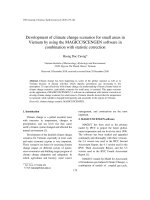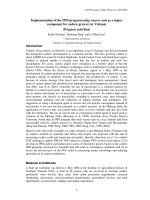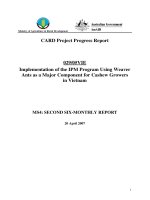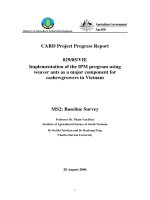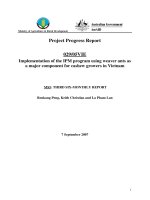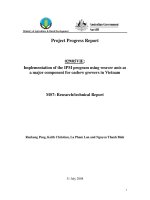Margin trading recommendations for the application in Vietnam securities market
Bạn đang xem bản rút gọn của tài liệu. Xem và tải ngay bản đầy đủ của tài liệu tại đây (698.37 KB, 193 trang )
MINISTRY OF EDUCATION AND TRAINING
UNIVERSITY OF ECONOMICS HOCHIMINH CITY
NGUYEN THANH HAI
MARGIN TRADING
RECOMMENDATIONS FOR THE APPLICATION
IN VIETNAM SECURITIES MARKET
MASTER’S THESIS
Faculty of Banking
Ho Chi Minh City 2010
MINISTRY OF EDUCATION AND TRAINING
UNIVERSITY OF ECONOMICS HOCHIMINH CITY
NGUYEN THANH HAI
MARGIN TRADING
RECOMMENDATIONS FOR THE APPLICATION
IN VIETNAM SECURITIES MARKET
MASTER’S THESIS
Major: Banking and Finance
Major code: 60.31.12
Supervisor
Associate Professor Ph.D. Tran Huy Hoang
Faculty of Banking
Ho Chi Minh City
i
Acknowledgement
It is a pleasure to thank many people who spent their time and made this thesis
possible.
Firstly, I would like to express my deep and sincere gratitude to my supervisor,
Associate Professor Ph.D. Tran Huy Hoang, Dean of Banking Faculty of University
of Economics, Ho Chi Minh City for his invaluable advice, guidelines and
encouragement during the course and development of my thesis. I would like to also
give my thanks to the teaching staff of the University of Economics, Ho Chi Minh
City, who have taught me to get in-depth knowledge which becomes an important
basis for the present thesis during my learning time.
My special thanks goes to Ms. Yei Pheck Joo, Josephine - General Director of
SaiGonBank Berjaya Securities Joint Stock Company for her kind support in
learning about the principles and processes of margin trading applied in Malaysia
securities market, particularly the margin trading processes being currently applied
in Inter-Pacific Securities Sdn Bhn – a securities company of Berjaya Corporation
Berhad in Malaysia, and in revising the English of my manuscript for this research.
I would like to extend my thanks to Vietnam Association of Securities Business
(VASB) for assisting me in obtaining the appropriate data and information on
securities and Vietnam securities market, in giving me favorable conditions to
exchange very helpful knowledge for this study with the VASB’s members.
And not forgetting, I am also very grateful to the supports of my best friends as
graduate students in Banking K16 class and many colleagues in SaiGonBank
Berjaya Securities Joint Stock Company, who have shared precious experiences and
understanding as well as have given me cheerful help to complete my thesis with
the best possible result
ii
Lastly, I wish to express my gratitude towards my wife who always stands by me
for her kind concern, loving support and cheer during my long thesis-writing period.
iii
Abstract
I hereby declare that this thesis submission is my own work with the guidance of
my supervisor or any contributions by others have been duly acknowledged, that all
information in this paper has been obtained from legal sources and disclosed in the
mass media and that, (to the best of my knowledge and belief,) it contains no
material previously published or written by another person (except where explicitly
referenced)
iv
Glossary of terms and abbreviations
SEC : Securities and Exchange Commission
SSC : State Securities Commission
Hose : Hochiminh Stock Exchange
HNX : Hanoi Stock Exchange
VSD : Vietnam Securities Depository
VASB : Vietnam Association of Securities Business
BIDV : Bank for Investment and Development of Vietnam
VN – Index : Vietnam Index of Hochiminh Stock Exchange
Hnx – Index : Hano Index of Hanoi Stock Exchange
Upcom : Unlisted Public Company Market
Repo : Repurchase Agreement
NAICS 2007 : The North American Industry Classification System
v
TABLE OF CONTENT
Acknowledgement
Abstract
Table of content
List of figure
CHAPTER I: INTRODUCTION 1
1.1 Research basis 1
1.2 Research matters 3
1.3 Research target 4
1.4 Research scope and approach 5
1.5 Real meaning of the research 7
1.6 Structure of the thesis 8
CHAPTER II: INTRODUCTION OF SECURITIES MARGIN TRADING 9
2.1 Introduction 9
2.2 The history of margin trading on international securities market 9
2.2.1 The history of margin trading and securities margin trading 9
2.2.1.1 The history of margin 9
2.2.1.2 Margin trading in securities market 11
2.2.2 The brief history of margin trading applying to other countries 13
2.2.2.1 U.S Securities market 13
2.2.2.2 China securities market 15
2.2.2.3 Malaysia Securities market 17
2.3 Margin trading and definitions 23
2.3.1 Some definitions of margin trading 23
2.3.2 Trading in margin account 26
2.3.2.1 The stock price increases and the margin account has the excess equity
value 27
2.3.2.2 The stock price drops and maintenance of the margin account 29
2.3.2.3 Trading on the limited margin account 30
vi
2.4 Conclusion 31
CHAPTER III: VIETNAM SECURITIES MARKET AND THE DEMAND OF
MARGIN TRADING 32
3.1 Introduction 32
3.2 Vietnam securities market 33
3.2.1 Development stages of Vietnam securities market 33
3.2.2 General view of trading rules currently applied 35
3.2.2.1 Matching hours and methods 35
3.2.2.2 Trading rules of the investors 36
3.3 The demand of diversification of securities trading methods 37
3.3.1 Cash advance service 37
3.3.2 Securities Repo and mortgage 38
3.3.3 The service of “financing support” 40
3.4 Conclusion 44
CHAPTER IV: LIMITATION OF PARTICIPANTS IN VIETNAM SECURITIES
MARKET
4.1 Introduction 46
4.2 Limitations of participants in the market 47
4.2.1 State agencies of securities and securities market 47
4.2.1.1 The legal documents do not meet the real practice in securities market 47
4.2.1.2 Government manages the market by temporary solutions 49
4.2.1.3 Treatment for the violations in the securities market has not been
satisfactory 50
4.2.1.4 Regulation for each investor to open only one custody account and not
to be allowed to buy and sell same stock in the same session 52
4.2.2 The supporting intermediate organizations 52
4.2.2.1 Short trading time and late clearing and settlement 53
4.2.2.2 Vietnam Securities Depository manages custody accounts by 02 levels . 55
4.2.2.3 The lateness and inappropriateness of independent auditor’s opinion 56
vii
4.2.2.4 Lack of an independent department in charge of supervising and
solving information in the market 58
4.2.3 Shares of listed companies 60
4.2.3.1 Unawareness of compliance on disclosure of information in the
securities market 63
4.2.3.2 Management power of companies is based on capital 64
4.2.3.3 Financial investment and risky activities 65
4.2.4 Participants doing business in the securities market 66
4.2.4.1 Securities companies 68
4.2.4.1.1 Small capital and investment into risky activities 69
4.2.4.1.2 Business results mainly depends on the self – trading activity 71
4.2.4.1.3 Information technology system has not met the trading demands of
investors 72
4.2.4.1.4 Internal control and risk management system have not been paid
proper attention 72
4.2.4.1.5 Internal procedures and policy of margin trading has not been set up 74
4.2.4.2 Fund management companies and securities investment companies 75
4.2.4.3 Securities investors 76
4.3 Conclusion 78
CHAPTER V: RECOMMENDATION FOR THE APPLICATION OF MARGIN
TRADING
5.1 Introduction 79
5.2 Recommendations for the application of margin trading 79
5.2.1 For State agencies 79
5.2.1.1 Completing the system of legal documents regarding securities and
securities market 79
5.2.1.2 Enhancing the equitization process of State-owned enterprises 80
5.2.1.3 Promulgating specific regulations on margin trading activity 81
5.2.2 Supporting intermediate organizations 84
viii
5.2.2.1 Vietnam Securities Depository (“VSD”) 84
5.2.2.2 Stock exchanges 85
5.2.2.3 Accredited audit firm 86
5.2.2.4 An organization in charge of assessing the business confidence
should be set up to have the basis for sector classification 87
5.2.3 Goods – Listed companies and unlisted public companies 88
5.2.3.1 The market needs more qualified and diversified stocks 88
5.2.3.2 Business results should be enhanced and risky activities should be
avoided investing in 89
5.2.3.3 The purpose of listing must be determined and pursued 89
5.2.4 Participants doing business in the securities market 90
5.2.4.1 Fund management companies 90
5.2.4.2 Investors 91
5.2.4.3 Securities companies 92
5.2.4.3.1 Enhancing the capital mobilization to serve the operation after crisis 92
5.2.4.3.2 Properly allocating the power sources without relying on risky self-
trading activity 93
5.2.4.3.3 Enhancing the information technology system serving for trading 94
5.2.4.3.4 Completing and maintaining the internal control and risk management
system effectively 94
5.2.4.3.5 Margin trading activity 95
5.3 Conclusion 105
REFERENCES
- Appendix 1: List of 50 highest capitalization stocks on the market as of 16th
March 2010 109
- Appendix 2: Financial investment situation of listed companies at hose 113
- Appendix 3: Legal documents applied in the securities market as of 30th April
2010 120
ix
- Appendix 4: The capital, profit and loss of the securities companies at 31st
December 2009 (unit: mill. VND) 176
- Appendix 5: Organization chart of Vietnam securities market 181
LIST OF FIGURES
- Figure 1.1: The structure of the study
- Figure 2.1: The initial margin rates
- Figure 2.2: Trading in margin account and the margin account has the excess
equity value
- Figure 2.3: Trading in margin account and maintenance of the margin account
- Figure 3.1: Statement of trading volume from April to December of the years
2008 and 2009
- Figure 3.2: Statement of trading situation in the last 3 months of 2009 under the
pressure of securities mortgage release
- Figure 4.1: A real case violation on using the inside information
- Figure 4.2: Statistics of listed securities companies in the market
- Figure 4.3: Listing activities in the securities market
- Figure 4.4: Statistics of custody accounts
- Figure 4.5: Statistics of securities companies’ capital scale
- Figure 5.1: Proposal the initial margin rate and minimum margin ratio
- Figure 5.2: Proposal the dossiers related to opening the margin trading account
x
LIST OF TABLE
- Table 2.1: The benefits and risks of investors and securities companies in
applying securities margin trading
- Table 4.1: Legal documents applied in Vietnam securities market
- Table 4.2: Situation of violating Securities Law
- Table 4.3: The system of accounts in settlement and clearing transactions of
cash and securities in the market
- Table 4.4: Listing conditions
CHART
- Flow chart 5.1: Margin financing procedures
- Flow chart 5.2: Credit control procedures
1
CHAPTER I: INTRODUCTION
1.1. Research basis
Securities market is an effective channel of capital mobilization for the
national economy; so, its establishment and development in developing countries
are very necessary. Together with the fast expansion of securities market in other
countries, the establishment of Vietnam securities market is an indispensable trend
in the process of economic growth and integration in the region as well as in the
world. During its development course, the countenance of Vietnam securities
market has continually changed and the Vietnam securities market has become an
important channel of capital mobilization in medium and long terms in the process
of national industrialization and modernization.
Vietnam securities market has officially come into operation since 20 July
2000, from which it is 10 years old now. Although it has still been too young in
comparison with the securities markets of other countries with hundreds of years,
the Vietnam securities market has gotten many considerable achievements such as
the capitalization rate of 40% of GDP, exceeding the norm of the Government (10 -
15% of GDP), the gradually perfected legal documents, the increasing numbers of
listed companies and the investors participating in the market and the attraction of
the interest of local and overseas investors. The occasion of 10 years of
establishment and development of Vietnam securities market is also the occasion to
revaluate the achievements attained as well as the shortcomings need to be
perfected so that the Vietnam securities market can become more stable and play
the role of effective channel of capital mobilization in the economy.
Vietnam securities market has started since 20
th
July 2000, in such a short
period of time, though it has experienced many ups and downs. From a small
number of transactions during 2001 - 2003 with some of securities codes to the
boom of trading volume during 2006 - 2007, and until the period of 2008 - 2009, we
2
have seen the sharp decline of the market. In addition to the reason of unstable
situation of the world’s economy, the immanent reasons are the wave of
speculation, the gap in the law, the issues in the management policy of currency
market and capital market in Vietnam. After significant fluctuations in the market,
the trading situation seems to be quieter at the moment. In the busiest trading days,
the trading value reached even over VND 11.000 billion/day, but at present, the
trading value is only around from VND 1.000 billion to VND 1.500 billion/day.
Another important reason of the gloominess of Vietnam securities market is the lack
of diversification of trading method in the stock market, leading to the excessive
decline of the liquidity in a long time and the loss of the attraction of this
investment channel and the obstruction of the capital mobilization channel of the
economy.
In order to increase the attraction of the securities market from the investors, to
gradually diversify the stock trading method, to enhance the operating effectiveness
of the securities market and to broaden the capital mobilization channel of the
economy, the diversification of trading method is very necessary, especially the
“Margin trading” which is considered a trading method helping to sharply increase
the liquidity of the market. This trading method has been being applied popularly in
the countries having developed securities market and is an indispensable demand of
emergent securities markets in their growing process. However, the application of
margin trading method in Vietnam securities market should be considered and
prepared with certain basic conditions such as the requirements on legal framework,
the readiness of the participants on the securities market, the demand on risk
management of securities companies - organizations having operations directly
related to the margin trading activity because in addition to the advantages of this
trading method, there are some implicit risks may not only occur to the participants
on the market, but also cause the effects on the whole system of securities market.
3
Therefore, the application of margin trading method would be an
indispensable demand in the growing course of securities market. The research on
the securities market reality and the participants on the market to offer
recommendations for preparing the application of the margin trading method is very
necessary to maximize the benefits from the application as well as to minimize its
risks. And that is the reason why I select the topic “SECURITIES MARGIN
TRADING AND RECOMMENDATIONS FOR THE PREPARATION OF
APPLYING MARGIN TRADING IN VIETNAM SECURITIES MARKET”
1.2. Research matters
Margin trading method has been being applied popularly in the countries having
developed securities market. This is one of the methods that aim to diversify the
trading method, to raise the liquidity for the market and to help the investors have
more trading methods to maximize their profits. The application of this method in
Vietnam securities market to meet the demand of the market is indispensable to the
growing process of Vietnam securities market according to the Government
guidelines. This thesis focuses on the margin trading method, the reality of Vietnam
securities market and the subjects trading in Vietnam securities market, including
the following issues:
- The first issue mentioned is the State agency in charge of securities and
securities market. The State manages Vietnam securities market by means of the
system of legal documents. This thesis concentrates on analyzing the limitations in
the system of legal documents related to securities and securities market, then
giving suggestions to develop securities market as well as the application of margin
trading method.
4
- The second issue mentioned is the intermediate organizations giving supports
to the securities market (hereinafter referred to as “the supporting intermediate
organizations”) including Vietnam Securities Depository (“VSD” for short),
Designated Settlement Bank and accredited audit organizations. This thesis also
analyzes the existing limitations of the supporting intermediate organizations
providing supports to the securities market with the intermediary role of supporting
trading information, performing transactions and making payment in securities
market, then gives suggestions for improving the operation structure of intermediary
organizations to develop the securities market and recommendations for applying
margin trading method.
- The third issue mentioned is stocks, which are considered goods in securities
market. The analyzation of figures and assessment about the reality of listed
companies in Ho Chi Minh City Stock Exchange (hereinafter referred to as
“HOSE”) help to present the limitations and recommendations for applying margin
trading method as well as for speeding up the growth of securities market.
- The last issue is the research on the existing limitations of participants doing
business in the securities market including investors, organizations, local and
overseas individuals, fund management companies, especially securities companies
- subjects directly providing margin trading service. This part of the thesis goes into
the details of researching the reality of securities companies and then gives the
recommendations in preparing for applying margin trading method.
Since the thesis is about margin trading, only the subjects and contents related to the
application of margin trading in securities market are focused on upon the research.
1.3. Research target
The research target of this thesis is to give practical and useful recommendations for
market participants in applying the margin trading method, including the
suggestions to perfect the existing shortcomings and to supplement the solutions so
5
that the application of this method of the participants could be effective as well as
the possible risks during the course of application could be minimized. The research
target of this thesis aims to solve the following issues:
- What is margin trading? What are basic rules in margin trading according to
the international practice? These questions will be answered in Chapter II of this
thesis.
- Should the margin trading method be applied to Vietnam securities market?
This issue will be presented in Chapter III.
- What are the participants in the securities market? What are the limitations of
these participants in applying margin trading method in Vietnam securities market?
These contents will be replied in Chapter IV.
- What are recommendations for each type of market participants in applying
margin trading method? This content will be detailed in Chapter V.
- What are specific recommendations for securities companies – mainly
related subject in providing margin trading service? The answer will also be
detailed in Chapter V.
The research target of this thesis is not only to point out the existing limitations of
each market participant with different roles, responsibilities and purposes related to
margin trading method, but also to offer specific recommendations for application
of this method to each participant, especially the securities companies, which are
the organizations providing margin trading service to their clients in Vietnam
securities market.
1.4. Research scope and approach
Firstly, this thesis only focuses on the margin trading scope. Margin trading
includes buying first and then selling (also known as “buying on margin”) and
selling first and then buying (also known as “short selling”). Therefore, the term
6
“margin trading” or “securities trading” used in this thesis means the transaction of
buying on margin.
Secondly, this thesis only focuses in researching the actual situation of Vietnam
securities market and its participants including the State agencies in charge of
managing the securities market, the supporting intermediate organizations with the
intermediary role of supporting trading information, performing transactions and
making payment in the market, the listed companies and particularly the
participants in the market having activities directly related to margin trading
method.
The research approach used during the course of doing the thesis includes:
- Collection of information: The information and data have been collected via
many sources of materials related to margin trading in the countries having
developed securities market such as the United States, China and Malaysia and via
the margin trading processes actually applied in Inter Pacific Securities Sdn Bhd.
The figures have been placed on the mass media, the securities magazines, the
annual reports of the stock exchange and of listed joint stock companies in Vietnam
securities market, the legal documents and financial statements systematized of
listed and securities companies.
- Statistics of figures: On the basis of the information collected, the
information data will be systematized to serve the specific research targets.
- Analysis: The analyses of tendency and ratio are performed to serve the
specific research targets of the thesis.
- Assessment of analytical results: Basing on the results of the collections,
statistics, comparison, the assessment of analytical results is given to the research
targets of the thesis.
The research approach of the thesis is mainly applied in the process of analyzing,
assessing the reality of securities market and the market participants. The results
7
drew from these assessments are regarded as the basis to offer the recommendations
related to the application of margin trading method.
1.5. Real meaning of the research
Margin trading method has been being popularly applied to the countries having
developed securities market, which is considered as indispensable to meet the
demand of the market. Vietnam securities market has come into operation for 10
round years. In addition to the considerable achievements in the initial stage,
Vietnam securities market has still not fully developed as compared with that of
other countries, namely the lacks of trading methods that help to maximize the
profit or risk defensive products such as Option, Future, Repo and margin trading
method. Margin trading is regarded as a trading method that gives much support to
the liquidity of the market, increases the possibility of maximizing the profit of the
investors, but also contains many risks. In order to satisfy the demand of the market
and of the participants in Vietnam securities market, the application of margin
trading is an essential requirement.
Apart from introducing the margin trading method and its rules, this thesis also
offers recommendations for application of this method to the market participants,
including the following issues:
- The State agencies should have certain measures to manage the trading
method in the securities market to ensure the stability and the solidity of the market.
- The supporting intermediate organizations have to repair the shortcomings,
perform their intermediary roles of information, transaction and settlement in the
market well to clear the flow of trading stocks.
- The listed companies should follow the legal regulations on securities and
securities market, select proper development direction to raise their values as well
as to minimize possible risks during the operation course so that the stock traders
can get enough information and reach the investment target via margin trading
method.
8
- Participants doing business in the securities market, especially the securities
companies – organizations providing margin trading service should carry out the
measures to effectively operate and to manage the risks during the course of
operation as well as of providing margin trading service.
From the actual demand of Vietnam securities market about the application of
margin trading and in order to help the market participants, especially the
participants having directly related operations, fully prepare for the application of
this method, achieve the highest effect and manage the arising risks, this thesis is
presented and expected to solve the tasks mentioned above to maintain the stability
and solidity of Vietnam securities market that will become an effective channel of
capital mobilization in medium and long terms of the economy.
1.6. Structure of the thesis
Figure 1.1 Structure of the study
Chapter I Introduction
Chapter II
Introduction of margin trading
Chapter III
Vietnam securities market and the
demand of margin trading
Chapter IV
Limitations of participants in Vietnam
securities market
Chapter V
Recommendations for application of
margin trading
9
CHAPTER II
INTRODUCTION OF SECURITIES MARGIN TRADING
2.1 Introduction
Margin trading is a new concept for the securities market as well as the investors of
Vietnam securities market. The main content of this Chapter summarizes the
margin trading and the practice of margin trading applied to the countries having
developed securities market, including:
- Introduction of history of the margin trading. This content shows the origin
of the securities margin.
- Practice of margin trading which has been applied at the countries having
developed securities market.
- Introduction of securities margin trading.
Studying the history of margin trading and the practice of margin trading which has
been applied at the countries having developed securities market helps us have
overall knowledge about particular characteristics of margin trading in these
counties. And in the development trend of securities market, the application of the
margin trading is indispensable trend that meet the demand of the market, the
requirement of multi-trading methods in order to increase the liquidity and more the
attraction of securities market for investors. Besides, this chapter also introduces the
principles of margin trading by some concepts related to the margin trading and the
illustrations of some trading principles and method applied in accordance with
international practice.
2.2 The history of margin trading on international securities market
2.2.1 The history of margin trading and securities margin trading
2.2.1.1 The history of margin
10
Originally, the principle of margin trading was associated with transactions in
commodity markets. In XIX century, commodity exchanges were the markets,
where payment for commercial transactions was made in cash. Intermediaries at
these markets were brokers, who rendered services for execution of transactions,
money transfer and maintenance of accounts. While maintaining accounts, brokers
used a special accounting method, which was called 'circular'. This method allowed
payments between clients in the most efficient way in case of repeated resale of
goods.
The circular accounting method was used at futures markets until the 1920's, when
it was able to satisfy the needs of futures markets. The method assumed that
exchange members, when making transactions, fulfill his obligations as immediate
participants of the agreement. They used to bear full responsibility for fulfillment of
contract obligations. With such a settlement system the clients had an advantage
that it was unnecessary to use own funds as a financial guarantee of fulfillment of a
stock contract, and it cheapened stock trading for them.
Earlier settlement procedures were more preferable for that stage of stock trading,
when most of transactions were purely commodity-merchandise, i.e. purchases and
sales were based on real needs for goods or goods themselves. Exchange members
had to own considerable funds to guarantee fulfillment of his obligations in any
case.
At modern stock exchanges a lot of speculative operations are carried out. In some
economical situations, share of speculative operations increases dramatically, which
may cause insolvency of clients and, consequently, of other exchange members.
Growth of futures operations and increase of associated risks led to appearance of
the clearing system for settlements of transactions, as well as a special division of
the stock exchange - the clearing house (settlement house). Now every futures
11
exchange or dealing center has a clearing mechanism, which ensures conclusion of
all transactions in the market.
The basis of clearing settlements is a system of deposits or guarantee deposits,
required from participants of futures operations. In exchange practice, such deposits
are called a margin.
2.2.1.2 Margin trading in securities market
The term of margin has multiple interpretations. Thus, in the securities market, the
margin means money borrowed from securities company for purchase of securities.
In the USA, the percentage of cash funds to be placed with the broker for purchase
of securities is established by the Federal Reserve System and since 1974 is equal to
50% for common stocks. That is to say, the broker provides the client with leverage
ratio 1:2. So, the investor can purchase securities for $20,000, depositing $10,000
and borrowing the rest from the broker. The loan is charge with interest, and
securities serve as a guarantee.
In recent years, due to the investment boom and introduction of such an instrument
as a CFD contract, leverage ratio 1:10 has become a common practice in CFD for
common stocks, precious metals and other financial instruments.
The system of operation via a dealing (brokerage) company with provision of a
credit leverage was called “margin trading”. Margin trading is attractive due to its
accessibility. High profitability of the securities market is attractive for investment
in securities of the leading foreign countries. However, amount of dividends directly
depends on successful performance of a concrete enterprise and preferences of its
stockholders. It is more interesting to buy stock in order to speculate for his rise, but
it requires considerable investments. Margin trading does not have the described
limitation. You can sell and buy financial assets, depending on your expectations.
12
Margin trading allows experienced participants in financial markets to maximize
efficiency of transactions in the securities market.
However, it should be remembered that the leverage linearly increases any financial
result, both positive and negative. By opening a position with leverage, the client
increases his market risk proportionally to the leverage amount and can lose all his
capital because of an adverse market conditions. Thus, uncontrollable losses from
clients' positions may cause solvency crises of participants and lead to the market
collapse.
Table 01: The benefits and risks of investors and securities companies in
applying securities margin trading
The benefits of investors The benefits of securities companies
Investors can buy larger volume of stocks
with an amount of cash, or buy a volume
of stocks with smaller cash amount.
Securities companies can earn more
income from interests of credit amount on
margin account.
By borrowing money from the securities
company on the basis of pledged stocks
on margin account, investors can
implement the leverage on investment.
By buying stocks on margin trading
method, they have an opportunity to get
the same profit as buying stocks in cash,
but it is not necessary to pay with their
money. The profit increases twice.
With amounts of cash and loan, investors
increase capacity of transactions, so
securities companies will earn more
brokerage fee.
Risks
In case the stock price drops after buying,
investors will lose money twice by using
leverage.
Similar to other credit institutions in
providing credit to clients. In case
the collateral value drops and the
market liquidity is poor, securities
companies difficultly recover the
credit from collateral value.
13
2.2.2 The brief history of margin trading applying to other countries
2.2.2.1 U.S Securities market
U.S Securities market has been born for 200 years. At that time Banks began to
increase money by issuing bonds and stocks to mobilize the capital. Not too later
from 17
th
May 1792, New York Stock Exchange (“NYSE” for short) was
established at Wall Street. In the period of years 1800, U.S economy grew quickly.
And in the period of years 1900, millions of USD of securities was exchanged on
street market. This market was called “Curd Market” because all transactions were
conducted on the street. In year 1921, after 20 years trading on the street, the
securities market moved into office. The history created the “Industrial revolution”
for US, playing an important role in changing the U.S securities market.
A new kind of investment method started to appearance when people had begun to
recognize the profit from selling stocks to others who realized the potential value of
companies. This was just the primary market, also known as the speculation market.
This market was easy to be very vaporized because it was impacted by the
subjective view of company’s future.
NYSE was considered as the first stock exchange worldwide because the trading
volume at that time was very high, and the listed companies were established and
had the stable development for long time.
Until 80 years after the appearance of securities market, The Government issued
some regulations in order to protect investors on securities investment. These
regulations were promulgated in 1934. At that time a big securities collapses
(known as “Great cash”) was occurred; therefore, the Congress promulgated some
trading and warranty regulations. Securities and Exchange Commission
(abbreviated to “SEC”) was established after that. SEC held some rules derived
from Regulation T and continued emending and supplementing the contents of rules

